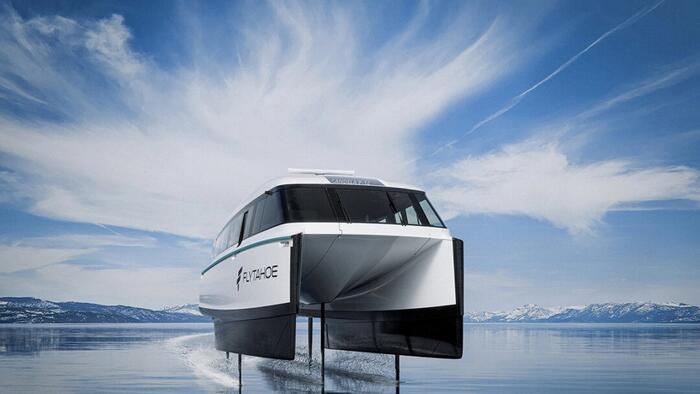Lake Tahoe, a popular tourist destination, is set to welcome the first electric hydrofoil ferry in the United States, a significant innovation designed to ease transportation across the scenic area. The ferry, developed through a collaboration between Swedish technology firm Candela and U.S. operator FlyTahoe, takes advantage of advanced hydrofoil wings that lift its hull above the water, providing a fast, efficient transit option across the lake. While a similar ferry launch occurred in Stockholm recently, the Candela P-12 ferry is anticipated to dramatically reduce travel time across Lake Tahoe’s north-south span, taking only 30 minutes compared to the approximately three-hour drive around the lake.
The frequent travel around Lake Tahoe, undertaken by millions annually, has raised concerns about environmental impact. Ryan Meinzer, the founder and CEO of FlyTahoe, articulated that tire wear and road sediment directly contribute to ecological issues, including the degradation of Lake Tahoe’s famed clarity. This sediment not only impacts air quality but also adversely affects the lake, which serves as a major watershed. With over 15 million visitors to Tahoe in the past year and an average of 20,000 trips daily across the north and south of the lake, Meinzer outlined his decision to focus FlyTahoe’s operations specifically on this busy route to address these environmental challenges.
In a recent announcement, Candela highlighted that the P-12 hydrofoil ferry is not only the fastest electric vessel globally, reaching speeds of 25 knots (approximately 30 mph), but also boasts a remarkable energy efficiency, consuming 80% less power than traditional vessels. The design of the hydrofoil wings plays a crucial role in minimizing drag and promoting a smooth, silent experience for passengers. The ferry employs similar principles to jet fighters, utilizing technology and sensors to maintain a balanced position while traveling over water. This unique engineering promises not only speed but also a comfortable ride, appealing to both locals and tourists alike.
Despite the promising technology, Meinzer faces various challenges as he navigates the complexities of maritime operations. Ensuring compliance with local and federal regulations, such as the Jones Act, which governs maritime commerce in U.S. waters, is imperative for FlyTahoe. Meinzer emphasized the importance of meeting stringent safety standards, as the hydrofoil ferry will be operating over a natural body of water. Additionally, there are infrastructure hurdles to overcome, particularly regarding the availability and installation of electric boat charging stations around Lake Tahoe, which are essential for supporting not only the hydrofoil service but also the growing market for electric boating in general.
Potential operational specifics for the ferry are still being finalized, with plans not yet completed for the pickup and drop-off locations, boat storage, or parking options. However, the ferry is projected to accommodate up to 30 passengers per trip, with the added benefit of being wheelchair accessible and capable of carrying equipment like snowboards, skis, and bicycles. The expected price for a one-way ferry trip across the lake is approximately $50, although Meinzer envisions the possibility of offering lower fares through government grants, ultimately improving accessibility for visitors.
The hydrofoil ferry is slated to commence operations in late 2025 or early 2026, marking a significant leap towards sustainable transportation in the Lake Tahoe region. Meinzer’s vision extends beyond a single vessel, aiming for a future fleet of electric hydrofoil ferries that enhance connectivity while prioritizing environmental preservation. This initiative reflects a broader trend towards eco-friendly solutions in tourism and transportation, balancing the need for convenience with a commitment to protecting the natural beauty of Lake Tahoe and its surrounding ecosystems.

